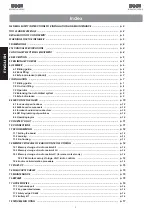
16
Changing Security Code
This keypad has a virtual dipswitch used to create your Security Code. The virtual dipswitch contains nine 3-
position switches. The default Security Code has all nine switches in the center position. To ensure neighboring
keypads do not interfere with each other, the virtual switches should be positioned in a random pattern, using
the following procedure.
Example of random positioning of the virtual dipswitches to create a Security Code is shown below. To enter
the Security Code, enter the dipswitch number, followed by the dipswitch position character. The Security
Code would be entered as:
1# 20 3* 4* 5# 6* 7# 80 9*
Switch Number
Dipswitch
Position
1 2 3 4 5 6 7 8 9
#
X X X
0
X X
*
X X X X
Use table below to create a random pattern and enter the resulting Security Code in the following
procedure.
Switch Number
Dipswitch
Position
1 2 3 4 5 6 7 8 9
#
0
*
1 Enter the Master Password.
2 Enter “6.” If correct, 2 short beeps (if 1 long beep is heard, start over with step 1.)
3 Enter the Security Code created in the table in the previous column. If correct, 2 short beep after each
switch number and switch position combination is entered.
4 Enter
“#.”
5 Enter
“6.”
6 If correct, 2 short beeps (if 1 long beep is heard, start over with step 1.)
Learning Access Codes in Receiver:
Create Communication With Receiver Relay 1:
(Security Code/Dip Switches)
1 Carry keypad to receiver location for programming.
2 Enter the Access Code for relay 1 on the keypad and continue to press the last key entered (red light
blinks.)
3 Press P1 (learn button) on the receiver until LD (green light) comes on and relay clicks.
Create Communication With Receiver Relay 2:
(Security Code/Dip Switches)
1 Carry keypad to receiver location for programming.
2 Enter the Access Code for relay 2 on the keypad and continue to press the last key entered (red light
blinks.)
3 Press P2 (learn button) on the receiver until LD (green light) comes on and relay clicks.
















































